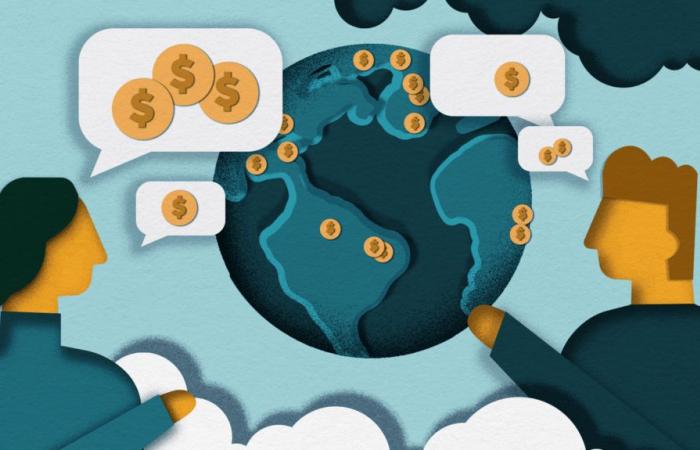
From November 11 to 22, COP29, which takes place in Azerbaijan, aims to unlock the financing necessary for developing countries to confront the climate crisis.
After the gradual exit from fossil fuels in Dubai last year, the COP is dedicated, this time, to financing the ecological transition. Or, as defined in the Paris agreement (document PDF)all the “financial flows compatible with a profile of evolution towards development with low greenhouse gas emissions and resilience to climate change”. More concretely, this 29th UN climate conference, which takes place from November 11 to 22 in Baku, Azerbaijan, aims to unlock the hundreds of billions of dollars necessary for developing countries to confront the climate crisis. “We need to create a financing shock”argued the office of the Minister of Ecological Transition, Agnès Pannier-Runacher. A subject which has already blocked the success of COP16 dedicated to the protection of biodiversity in early November.
This envelope, called in UN jargon “New Quantified Collective Goal” (NCQG), must replace that set in 2009. The latter provided for rich countries to provide $100 billion in annual aid to developing countries, a figure that has been painfully achieved. , late, in 2022.
“There is the specter of not achieving a new objective, and that would be a huge stone in the shoe,” alerts Lola Vallejo, director of the climate program at the Institute of Sustainable Development and International Relations (IDDRI). Because a few weeks before the start of the COP, experts and observers of the negotiations agreed that the latter were not “not very advanced”in the words of Yannick Glemarec, research director at the International Center for Research on Environment and Development (Cired). “Everything is a point of negotiation…” The French associations of the Climate Action Network have also expressed their concern, citing the “crisps” around the subject.
The amount, first of all. A draft agreement on this objective, published on October 15 by Egypt and Australia, designated as co-facilitators of the discussions, clearly showed the extent of the divisions between the blocs, with solutions ranging from “minimum of 100 billion” has “2 trillion dollars.” The donor countries (established in 1992 based on their historical responsibility for global warming: United States, European Union, Japan, United Kingdom, Canada, Switzerland, Turkey, Norway, Iceland, New Zealand and Australia) estimate some of these unrealistic amounts for their public finances. It will be “the last piece of the puzzle” during the negotiations, warned the French interim climate ambassador, Kevin Magron.
These countries also want to review the list of contributors. Arguing that they only represent 30% of historical emissions, they are calling for broadening the donor base to emerging countries, in particular China or the Gulf countries, who do not want to hear about it. The European Union, in a common position published on October 14, thus requested “a broader group of contributors”. “This would reflect the evolution of respective economic capacities and the increasing amounts of global greenhouse gas emissions since the early 1990s”we can read. The EU also emphasized that “private investment will have to provide the largest share of the investments required in the green transition”, “public finances will not [pouvant] alone achieve the necessary funding levels”.
There is a North/South opposition, with confidence which has fallen since the delay in reaching 100 billion dollars.
Lola Vallejo, director of Iddri's climate program
Especially since two thirds of the 100 billion annual dollars already granted are loans, accused of fueling the debt of poor countries. The potential points of disagreement therefore accumulate. “Who receives? Do the least developed countries and small island states receive more? On what issues? Are we creating a window on adaptation, another on the mitigation of global warming? This that we have, it is the result of 30 years of blockages and discussions which have not succeeded”draws Yannick Glemarec. The responses mentioned in the draft agreement appear to be very contradictory depending on the groups of countries. “Remaining in fixed positions (…) will leave too much ground to cover at COP29”warned Mukhtar Babaev, Azerbaijani Minister of Ecology and president of the conference, after a round of negotiations in mid-September.
Despite these questions, experts and NGOs welcome the necessary rise in the financial stakes during the COPs. “In terms of climate ambition, we are off the mark. And we will not get back on track without financing. This is the mechanism for implementing an increased ambition”argues Yannick Glemarec. He also recalls that the NCQG is not the only financial subject that should be addressed during this COP29. It remains to finalize the agreements, “blocked for years”, on carbon finance, this possibility given by article 6 of the Paris agreement to States to compensate for their greenhouse gas emissions by purchasing efforts made elsewhere. Or even to “capitalize the fund for losses and damages [adopté à Dubaï] and to make progress on the elimination financing for fossil fuels“list Yannick Glemarec.
We can also expect, as at each COP, agreements outside the official negotiations. “Private finance can have an extremely important role to play”defends Lucie Pinson, director of the NGO Reclaim Finance, who believes that the private sector “must represent 80% of the financing of energy transitions”. A first step in this direction has been taken, with the Action Fund for Climate Finance, an idea launched by Azerbaijan last July and which will bring together 1 billion dollars from “voluntary contributions from countries and companies producing fossil fuels”.
But the addition of all these funds, private and public, is far from sufficient. “If we add all climate funding, we reach 1,300 billion per year. To deal with climate change, we would need to have between 6,000 and 12,000 billion by 2030”warns Yannick Glemarec, relating to a study by the Climate policy initiative (document PDF). And this, with monitoring and controls, requires Reclaim Finance. “Let us not end up with the recent example [dénoncé en 2022 par l’ONG] of the proposed green bond… for the expansion of Hong Kong airport, under the pretext that the building is low energy consumption”critic Lucie Pinson. Because the definition of climate finance remains very vague at the moment, and therefore open to interpretation.





